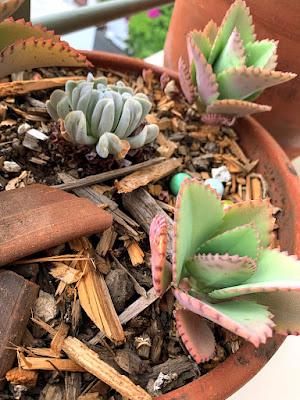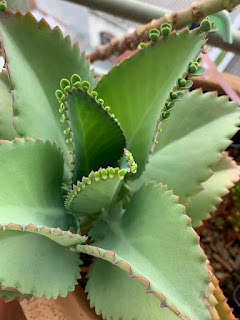The Plant that Came from Nowhere and Grows Everywhere
I am a plant person - a plant person without a garden or a yard or a farm. We have porches.
It's pretty amazing to see what will grow on a porch. I like to experiment with what might be considered garbage from things I get at the grocery store. Most Salvadoran produce is not hybrid, so saved seeds will germinate. Herbs are sold with the roots, so it sometimes works to cut off most of the herbs and stick the roots into a pot. I am currently experimenting with some little chunks of ginger that were no longer edible. After a couple of weeks in the soil, the roots are sprouting nice little stalks and leaves.
 |
| Ginger sprouting (©Linda Muth, 2023) |
Frequent travel makes porch gardening extra challenging. One option is to grow for a while and then give plants away. One time, I left a bucket of basil, rosemary and other herbs with Pastor Santiago's mom, and it produced abundantly until Santiago cut off too much. (He told me he was grateful for the learning experience.) Once I tried to rig up a porch pot water condensation and wicking irrigation system. That was less than successful. At this point, I basically let my plants fend for themselves (especially during the rainy season), which seems to give them about a 50/50 chance of survival.
 |
| Herb bucket in a repurposed dishpan (photo credit: Santiago) |
There is one plant, however, that really is a survivor. At some point, either hidden in the compost or blown in by the wind, a succulent appeared in one of my pots. It seemed like an OK plant, so I let it grow. I left for a while. When I came back, the succulent had friends. As an apparently self-propagating survivor, it seemed pretty perfect for the rugged environment of my porch. We started calling it "The Grow Everywhere Plant."
 |
| ©Linda Muth, 2023 |
Eventually we realized that the Grow Everywhere Plant makes babies on its leaves. The babies fall off, fly off, roll around, get stuck on things, and grow. EVERYWHERE. They grow in the pot saucers. They grow in the ceramic tile grout. They grow in the little tubes that take water off of the porch so we don't have a flood. (We found that out when we had a flood.) They grow ON the metal porch railing until the wind blows them off. This is a very annoying feature of the Grow Everywhere Plant. Now I am very proactive, and I pull the babies off of the leaves before they can escape beyond the pots.
 |
| Look out below! Time to pull these babies off and toss them into a pot or into the trash (Sorry, babies.) ©Linda Muth, 2023 |
After a dry spell two years ago, a few of the Grow Everywhere Plants put out tall shoots. I decided to let them go to see what would happen. The plants with shoots became sort of ugly and I planned to cut them down. Then, just like that, there were flowers at the top. Many of the adolescents plants have pink tinges in the leaves, but the pink flowers were still a surprise.
 |
| Flowers and babies (©Linda Muth) |
On a random day at a random street fair, someone gave me a little peanut cactus. I planted it into a porch pot. It survived and has also made flowers and babies. About a year ago, we visited the Sonoran Dessert. The succulents were amazing and beautiful and great inspiration for further development of a succulent porch garden, featuring the Grow Everywhere Plant.
 |
| Some of my clay pots are repurposed from our potable water filtration system. Repurposed water bottles help keep the birds from flying into the windows. (©Linda Muth, 2023) |
 |
| That little guy in the middle had a hard time being left alone during a very dry couple of months, but he's a survivor, too. (©Linda Muth, 2023) |
Last week, I asked my friend, Sonia, what name she uses for the Grow Everywhere Plants. (I pointed to a batch of them which are growing outside of the church in Los Héroes.) She said, "Well, I don't know its real name, but the name I use is 'Mala Madre' because it just tosses its babies everywhere, and that is a bad mother."
 |
| Mala Madre making babies (©Linda Muth, 2023) |
I searched for "Mala Madre El Salvador" online and learned that indeed, Sonia's name is the common name for the Grow Everywhere Plant, and Mala Madre is prolific throughout Central America. In the US, people usually call it "Mother of Thousands" or "Mother of Millions." This succulent is one of more than 120 species of Kalanchoe, which originated in Madagascar and parts of southern Africa. Kalanchoe are now present all over the tropical world. Based on my little bit of research, I believe the species I have on my porch is Kalanchoe Laetivirens.
 |
| This Buena Madre made her nest amidst the Mala Madre (©Linda Muth, 2022) |
Some species of Kalanchoe plants are useful as medicinals, but most seem to be considered toxic to humans and animals. The common Mala Madre that grows in El Salvador can be used as a wound healing agent in the same way that aloe is used. I actually found a video of Mala Madre being grown commercially by a small producer in Loma de Ramos, Guazapa as a preventative for cancer and other chronic diseases. Before using any medicinal plant, it is very important to consult with a plant expert to correctly identify the exact species and to follow the advice of a medical doctor regarding its use.
I'm pretty sure I will not chop up a Mala Madre leaf to put into my next salad, but I will continue to have fun watching my succulent garden grow. Last week I yanked out some of the hardened, dry stalks, and repotted some of the adolescent plants. The root systems on Mala Madre are really sturdy. I accidentally broke off a cluster of leaves, so I stuck it into the soil. It has already rooted. I also grafted a little chunk of peanut cactus onto a still viable Mala Madre stalk - another fun little experiment.
 |
| Young moms and their kids, well-rooted. (©Linda Muth, 2023) |
 |
| Really sophisticated graft using blue painter's tape and a twist-tie. |
You know, in Milwaukee, I also have a Grows Everywhere plant. It is also a succulent. It is edible - rich in Vitamin C. and native to Wisconsin forests. I will let you do the detective work and put your guess into the comments.



Purslane! That's the only succulent I can think of that grows on its own in Wisconsin. But I've never seen it in "forests," is there another I'm missing?
ReplyDelete